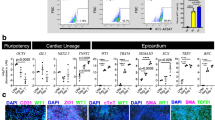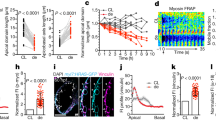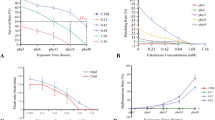Abstract
Aim:
Carbonaceous dots (CDs), which have been used for diagnosis, drug delivery and gene delivery, are accumulated in heart at high concentrations. To improve their biocompatibility, polyethylene glycol-modified CDs (PEG-CDs) were prepared. In this study we compared the cardiac toxicity of CDs and PEG-CDs in mouse and zebrafish models.
Methods:
Mice were intravenously treated with CDs (size: 4.9 nm, 5 mg·kg−1·d−1) or PEG-CDs (size: 8.3 nm, 5 mg·kg−1·d−1) for 21 d. Their blood biochemistry indices, ECG, and histological examination were examined for evaluation of cardiac toxicity. CDs or PEG-CDs was added in incubator of cmlc2 transgenic Zebrafish embryos at 6 hpf, and the shape and size of embryos' hearts were observed at 48 hpf using a fluorescent microscope. Furthermore, whole-mount in situ hybridization was used to examine the expression of early cardiac marker gene (clml2) at 48 hpf.
Results:
Administration of CDs or PEG-CDs in mice caused mild, but statistically insignificant reduction in serum creatine kinase (CK) and lactate dehydrogenase (LDH) levels detected at 7 d, which were returned to the respective control levels at 21 d. Neither CDs nor PEG-CDs caused significant changes in the morphology of heart cells. Administration of CDs, but not PEG-CDs, in mice caused marked increase of heart rate. Both CDs and PEG-CDs did not affect other ECG parameters. In the zebrafish embryos, addition of CDs (20 μg/mL) caused heart development delay, whereas addition of CDs (80 μg/mL) led to heart malformation. In contrast, PEG-CDs caused considerably small changes in heart development, which was consistent with the results from the in situ hybridization experiments.
Conclusion:
CDs causes greater cardiac toxicity, especially regarding heart development. Polyethylene glycol modification can attenuate the cardiac toxicity of CDs.
Similar content being viewed by others
Log in or create a free account to read this content
Gain free access to this article, as well as selected content from this journal and more on nature.com
or
References
Service RF . Nanotechnology grows up. Science 2004; 1732–4.
Wen Y, Meng WS . Recent in vivo evidences of particle-based delivery of small-nterfering RNA (siRNA) into solid tumors. J Pharm Innov 2014; 9: 158–73.
Wu J, Wu D, Mutschler MA, Chu C . Cationic hybrid hydrogels from amino-acid-based poly(ester amide): fabrication, characterization, and biological properties. Adv Funct Mater 2012; 22: 3815–23.
Ray PC, Yu H, Fu PP . Toxicity and environmental risks of nanomaterials: challenges and future needs. J Environ Sci Health C Environ Carcinog Ecotoxicol Rev 2009; 27: 1–35.
Qiao ZA, Guo B, Binder AJ, Chen J, Veith GM, Dai S . Controlled synthesis of mesoporous carbon nanostructures via a "silica-assisted" strategy. Nano Lett 2013; 13: 207–12.
Cao L, Meziani MJ, Sahu S, Sun YP . Photoluminescence properties of graphene versus other carbon nanomaterials. Acc Chem Res 2013; 46: 171–80.
Baker SN, Baker GA . Luminescent carbon nanodots: emergent nanolights. Angew Chem Int Ed Engl 2010; 49: 6726–44.
Ruan S, Zhu B, Zhang H, Chen J, Shen S, Qian J, et al. A simple one-step method for preparation of fluorescent carbon nanospheres and the potential application in cell organelles imaging. J Colloid Interface Sci 2014; 422: 25–9.
Ko HY, Chang YW, Paramasivam G, Jeong MS, Cho S, Kim S . In vivo imaging of tumour bearing near-infrared fluorescence-emitting carbon nanodots derived from tire soot. Chem Commun (Camb) 2013; 49: 10290–2.
Ruan S, Qian J, Shen S, Zhu J, Jiang X, He Q, et al. A simple one-step method to prepare fluorescent carbon dots and their potential application in non-invasive glioma imaging. Nanoscale 2014; 6: 10040–7.
Kim J, Park J, Kim H, Singha K, Kim WJ . Transfection and intracellular trafficking properties of carbon dot-gold nanoparticle molecular assembly conjugated with PEI-pDNA. Biomaterials 2013; 34: 7168–80.
Yu C, Li X, Zeng F, Zheng F, Wu S . Carbon-dot-based ratiometric fluorescent sensor for detecting hydrogen sulfide in aqueous media and inside live cells. Chem Commun (Camb) 2013; 49: 403–5.
Qian J, Ruan S, Cao X, Cun X, Chen J, Shen S, et al. Fluorescent carbonaceous nanospheres as biological probe for noninvasive brain imaging. J Colloid Interface Sci 2014; 436: 227–33.
Donaldson K, Duffin R, Langrish JP, Miller MR, Mills NL, Poland CA, et al. Nanoparticles and the cardiovascular system: a critical review. Nanomedicine (Lond) 2013; 8: 403–23.
Qian J, Chen J, Ruan S, Shen S, He Q, Jiang X, et al. Preparation and biological evaluation of photoluminescent carbonaceous nanospheres. J Colloid Interface Sci 2014; 429: 77–82.
Ruan S, Wan J, Fu Y, Han K, Li X, Chen J, et al. PEGylated fluorescent carbon nanoparticles for noninvasive heart imaging. Bioconjug Chem 2014; 25: 1061–8.
Jang GH, Hwang MP, Kim SY, Jang HS, Lee KH . A systematic in-vivo toxicity evaluation of nanophosphor particles via zebrafish models. Biomaterials 2014; 35: 440–9.
Kabashi E, Brustein E, Champagne N, Drapeau P . Zebrafish models for the functional genomics of neurogenetic disorders. Biochim Biophys Acta 2011; 1812: 335–45.
George S, Xia T, Rallo R, Zhao Y, Ji Z, Lin S, et al. Use of a high-throughput screening approach coupled with in vivo zebrafish embryo screening to develop hazard ranking for engineered nanomaterials. ACS Nano 2011; 5: 1805–17.
Liu CW, Xiong F, Jia HZ, Wang XL, Cheng H, Sun YH, et al. Graphene-based anticancer nanosystem and its biosafety evaluation using a zebrafish model. Biomacromolecules 2013; 14: 358–66.
Liu Y, Fang J, Kim YJ, Wong MK, Wang P . Codelivery of doxorubicin and paclitaxel by cross-linked multilamellar liposome enables synergistic antitumor activity. Mol Pharm 2014; 11: 1651–61.
Westerfield M . The zebrafish book: a guide for the laboratory use of zebrafish (Danio rerio). University of Oregon Press; 2000.
Thisse C, Thisse B . High-resolution in situ hybridization to whole-mount zebrafish embryos. Nat Protoc 2008; 3: 59–69.
Ruan S, Qian J, Shen S, Chen J, Zhu J, Jiang X, et al. Fluorescent carbonaceous nanodots for noninvasive glioma imaging after angiopep-2 decoration. Bioconjug Chem 2014; 25: 2252–9.
Ruan S, Qian J, Shen S, Chen J, Cun X, Zhu J, et al. Non-invasive imaging of breast cancer using RGDyK functionalized fluorescent carbonaceous nanospheres. RSC Adv 2015; 5: 25428–36.
Chen J, Sun H, Ruan S, Wang Y, Shen S, Xu W, et al. In vitro and in vivo toxicology of bare and PEGylated fluorescent carbonaceous nanodots in mice and zebrafish: the potential relation with autophagy. RSC Adv 2015; 5: 38547–57.
Tao H, Yang K, Ma Z, Wan J, Zhang Y, Kang Z, et al. In vivo NIR fluorescence imaging, biodistribution, and toxicology of photoluminescent carbon dots produced from carbon nanotubes and graphite. Small 2012; 8: 281–90.
Wang J, Zhang Z, Zha S, Zhu Y, Wu P, Ehrenberg B, et al. Carbon nanodots featuring efficient FRET for two-photon photodynamic cancer therapy with a low fs laser power density. Biomaterials 2014; 35: 9372–81.
Wang Q, Zhang C, Shen G, Liu H, Fu H, Cui D . Fluorescent carbon dots as an efficient siRNA nanocarrier for its interference therapy in gastric cancer cells. J Nanobiotechnology 2014; 12: 288.
Karacalioglu O, Arslan Z, Kilic S, Ozturk E, Ozguven M . Baseline serum levels of cardiac biomarkers in patients with stable coronary artery disease. Biomarkers 2007; 12: 533–40.
Odagiri F, Inoue H, Sugihara M, Suzuki T, Murayama T, Shioya T, et al. Effects of candesartan on electrical remodeling in the hearts of inherited dilated cardiomyopathy model mice. PLoS One 2014; 9: e101838.
Kurokawa J, Sasano T, Kodama M, Li M, Ebana Y, Harada N, et al. Aromatase knockout mice reveal an impact of estrogen on drug-induced alternation of murine electrocardiography parameters. J Toxicol Sci 2015; 40: 339–48.
Gao H, Pang Z, Jiang X . Targeted delivery of nano-therapeutics for major disorders of the central nervous system. Pharm Res 2013; 30: 2485–98.
Gao H, Zhang Q, Yu Z, He Q . Cell-penetrating peptide-based intelligent liposomal systems for enhanced drug delivery. Curr Pharm Biotechnol 2014; 15: 210–9.
Acknowledgements
The work was supported by grants from the National Natural Science Foundation of China (81402866 and 81301974) and the Sichuan University Starting Foundation for Young Teachers (2014SCU11044).
Author information
Authors and Affiliations
Corresponding authors
Rights and permissions
About this article
Cite this article
Chen, Jt., Sun, Hq., Wang, Wl. et al. Polyethylene glycol modification decreases the cardiac toxicity of carbonaceous dots in mouse and zebrafish models. Acta Pharmacol Sin 36, 1349–1355 (2015). https://doi.org/10.1038/aps.2015.100
Received:
Accepted:
Published:
Issue date:
DOI: https://doi.org/10.1038/aps.2015.100



